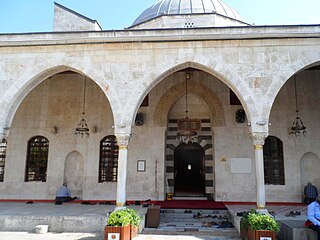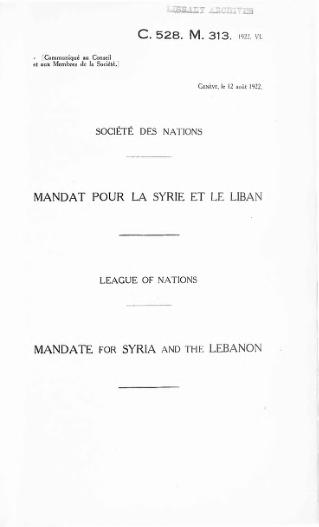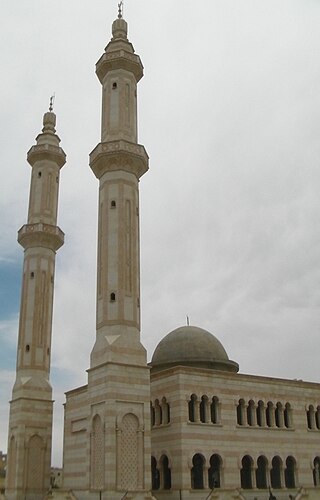Related Research Articles

Hatay Province is the southernmost province and metropolitan municipality of Turkey. Its area is 5,524 km2, and its population is 1,686,043 (2022). It is situated mostly outside Anatolia, along the eastern coast of the Levantine Sea. The province borders Syria to its south and east, the Turkish province of Adana to the northwest, Osmaniye to the north, and Gaziantep to the northeast. It is partially in Çukurova, a large fertile plain along Cilicia. Its administrative capital is Antakya, making it one of the three Turkish provinces not named after its administrative capital or any settlement. The second-largest city is İskenderun. Sovereignty over most of the province remains disputed with neighbouring Syria, which claims that the province had a demographic Arab majority, and was separated from itself against the stipulations of the French Mandate of Syria in the years following Syria's occupation by France after World War I.

A sanjak was an administrative division of the Ottoman Empire. The Ottomans also sometimes called the sanjak a liva from the name's calque in Arabic and Persian.

The administrative divisions of the Ottoman Empire were administrative divisions of the state organisation of the Ottoman Empire. Outside this system were various types of vassal and tributary states.

The Mandate for Syria and the Lebanon was a League of Nations mandate founded in the aftermath of the First World War and the partitioning of the Ottoman Empire, concerning Syria and Lebanon. The mandate system was supposed to differ from colonialism, with the governing country intended to act as a trustee until the inhabitants were considered eligible for self-government. At that point, the mandate would terminate and a sovereign state would be born.

Hatay State, also known informally as the Republic of Hatay, was a transitional political entity that existed from 7 September 1938 to 29 June 1939, being located in the territory of the Sanjak of Alexandretta of the French Mandate of Syria. The state was transformed de facto into the Hatay Province of Turkey on 7 July 1939, de jure joining the country on 23 July 1939.

The Sanjak of Alexandretta was a sanjak of the Mandate of Syria composed of two qadaas of the former Aleppo Vilayet. It became autonomous under Article 7 of the 1921 Treaty of Ankara: "A special administrative regime shall be established for the district of Alexandretta. The Turkish inhabitants of this district shall enjoy facility for their cultural development. The Turkish language shall have official recognition".

Turkish Kurdistan or Northern Kurdistan is the southeastern part of Turkey where Kurds form the predominant ethnic group. The Kurdish Institute of Paris estimates that there are 20 million Kurds living in Turkey, the majority of them in the southeast.

Azaz is a city in northwest Syria, roughly 20 miles north-northwest of Aleppo. According to the Syria Central Bureau of Statistics (CBS), Azaz had a population of 31,623 at the 2004 census. As of 2015, its inhabitants were almost entirely Sunni Muslims, mostly Arabs but also some Kurds and Turkmen.

Syrian Turkmen are Syrian citizens of Turkish origin who mainly trace their roots to Anatolia. Turkish-speaking Syrian Turkmen make up the third largest ethnic group in the country, after the Arabs and Kurds respectively.

The State of Aleppo was one of the six states that were established by the French High Commissioner of the Levant, General Henri Gouraud, in the French Mandate of Syria which followed the San Remo conference and the collapse of King Faisal I's short-lived Arab monarchy in Syria.

Ottoman Syria is a historiographical term used to describe the group of divisions of the Ottoman Empire within the region of Levant, usually defined as being east of the Mediterranean Sea, west of the Euphrates River, north of the Arabian Desert and south of the Taurus Mountains.

The Nablus Sanjak was an administrative area that existed throughout Ottoman rule in the Levant (1517–1917). It was administratively part of the Damascus Eyalet until 1864 when it became part of Syria Vilayet and then the Beirut Vilayet in 1888.

Hanna Mina was a Syrian novelist, described in Literature from the "Axis of Evil" as the country's "most prominent" writer.

The Vilayet of Aleppo was a first-level administrative division (vilayet) of the Ottoman Empire, centered on the city of Aleppo.

The Second Syrian Republic, officially the Syrian Republic from 1950 to 1958 and the Syrian Arab Republic from 1961 to 1963, succeeded the First Syrian Republic that had become de facto independent in April 1946 from the French Mandate. The Second Republic was founded on the Syrian Constitution of 1950, which was suspended from 1953 to 1954 under Adib Shishakli's strongmanship, and later when Syria joined with the Republic of Egypt in forming the United Arab Republic in 1958. The Second Republic resumed when Syria withdrew from the union in 1961. In 1963, the Syrian Ba'athist Party came to power in a bloodless military coup, which laid the foundations for the political structure in Ba'athist Syria.

Damascus Eyalet was an eyalet of the Ottoman Empire. Its reported area in the 19th century was 51,900 square kilometres (20,020 sq mi). It became an eyalet after the Ottomans took it from the Mamluks following the 1516–1517 Ottoman–Mamluk War. Janbirdi al-Ghazali, a Mamluk traitor, was made the first beylerbey of Damascus. The Damascus Eyalet was one of the first Ottoman provinces to become a vilayet after an administrative reform in 1865, and by 1867 it had been reformed into the Syria Vilayet.

The Mutasarrifate of Jerusalem, also known as the Sanjak of Jerusalem, was an Ottoman district with special administrative status established in 1872. The district encompassed Jerusalem as well as Hebron, Jaffa, Gaza and Beersheba. During the late Ottoman period, the Mutasarrifate of Jerusalem was commonly referred to as Palestine; a very late Ottoman document describes Palestine as including the Sanjak of Nablus and Sanjak of Akka (Acre) as well, more in line with European usage. It was the 7th most heavily populated region of the Ottoman Empire's 36 provinces.

The Syrian Resistance, formerly known as the Popular Front for the Liberation of the Sanjak of Iskandarun, is a Marxist-Leninist pro-Syrian government militia operating in northwest Syria prior to the fall of the Assad regime.
The Seferberlik was the mobilisation effected by the late Ottoman Empire during the Second Balkan War of 1913 and World War I from 1914 to 1918, which involved the forced conscription of Lebanese, Palestinian, Syrian, and Kurdish men to fight on its behalf as well as the deportation of 'numerous Lebanese & Syrian & Kurdish families' to Anatolia under Djemal (Cemal) Pasha's orders. Lebanese Syrians and Kurdish men accused of desertion were executed, and some 300,000 of the Arabs and Kurds who stayed behind died in the Lebanon famine, as Lebanon and Syria lost 75 to 90 percent of their crop production. Prostitution and cannibalism were also mentioned in reports or memoirs written after the end of the war.

The border between the Syrian Arab Republic and the Republic of Turkey is 909 kilometres (565 mi) long, and runs from the Mediterranean Sea in the west to the tripoint with Iraq in the east. It runs across Upper Mesopotamia for some 400 kilometres (250 mi), crossing the Euphrates and reaching as far as the Tigris. Much of the border follows the Southern Turkish stretch of the Baghdad Railway, roughly along the 37th parallel between the 37th and 42nd eastern meridians. In the west, it almost surrounds the Turkish Hatay Province, partly following the course of the Orontes River and reaching the Mediterranean coast at the foot of Jebel Aqra.
References
- ↑ Mina, Hanna (1977). Al-Mustanqa' (The Swamp). Dar Al-Adaab.
- ↑ "Al-Mustanqaa' (The Swamp) by Hanna Mina". Enab Baladi. 26 March 2017. Archived from the original on 12 December 2019.